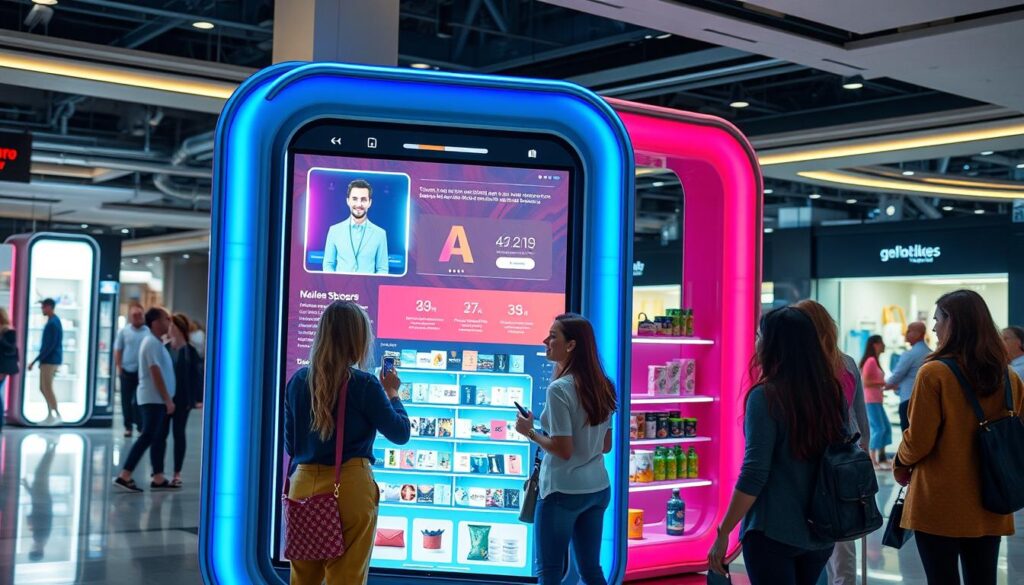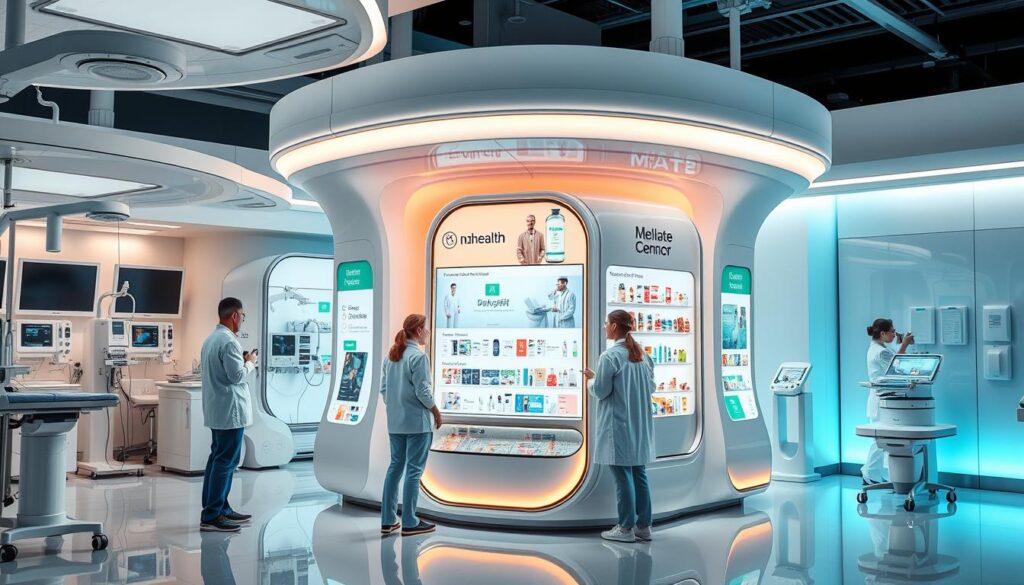Automated retail kiosks are changing how we shop, blending convenience with smart technology. They’re found in busy places like malls and airports. Here, you can find everything from DVDs and books to food, all without talking to anyone.
As technology grows, so does our preference for automated shopping. It’s clear that automation is here to stay, changing the way we buy things. About 73% of people prefer self-checkout, with Gen Z leading the way. This shows a big shift in retail, with automated kiosks becoming key to a better shopping experience.

Key Takeaways
- Automated retail kiosks provide easy access to a wide range of products.
- The technology behind these kiosks includes data transfer and wireless communication.
- These kiosks can significantly reduce operational costs compared to traditional retail stores.
- Self-service options are increasingly popular among consumers, specially Gen Z.
- Automated retail kiosks help mitigate theft and shrinkage in retail settings.
- The automated kiosk market is projected to reach $34 billion by 2023.
- Businesses benefit from improved efficiency and 24/7 customer service through kiosks.
Understanding the Concept
What is an Automated Retail Kiosk? Defining Features and Functionality
Automated retail kiosks change how we shop. They have easy-to-use touch screens and let you look through lots of products. They also keep your money safe and help businesses save money.
This smart technology makes shopping easier and more fun. It’s why automated kiosks are becoming more popular in many places.
Types of Automated Retail Kiosks: Exploring Different Models and Applications
There are many types of automated retail kiosks for different needs. Here are some examples:
- Self-checkout kiosks: These are common in stores and grocery shops. They let you pay for your items by yourself.
- Digital vending machines: You can find these in busy places like airports. They sell snacks, drinks, and even gadgets.
- Interactive kiosks: Companies like LEGO use them to make shopping fun. They have digital screens that entertain kids and parents alike.
How Automated Retail Kiosks Work: A Look at the Technology Behind the Scenes
Automated retail kiosks use advanced tech like AI and IoT. This tech lets them understand what you like and suggest things based on what you’ve bought before. It makes shopping smoother and more personal.
| Brand | Application | Location |
|---|---|---|
| Lego | High-tech vending machines | Malls, airports |
| Sprinkles Cupcakes | Refrigerated cupcake vending machines | Los Angeles |
| ProActive | Health-focused solutions | Airports, malls |
| Apple | High-end self-service kiosks | Airports, stores |
| REDYREF | Automated dispensing solutions | Healthcare, airports |
The future looks bright for automated retail kiosks. They can make a lot of money, even from small spaces. They’re a smart way for brands to save money without long leases. As tech gets better, so will the chances for these kiosks to grow.
Benefits of Automated Retail Kiosks
Automated retail kiosks bring many advantages to both shoppers and stores. They make shopping better and help stores work more smoothly. This boosts overall retail efficiency.
For Consumers: Convenience, Accessibility, and Personalized Experiences
Shoppers love how fast and easy automated kiosks make buying things. They don’t have to wait or talk to sales staff. This lets them shop privately, which is great for those who like personalized experiences.
As these machines get better, they offer more than just snacks. They have a wide range of products. This makes shopping more fun and complete.
For Retailers: Reduced Costs, Increased Efficiency, and Valuable Data Insights
Stores save money with automated kiosks. They don’t need as many employees at checkout. This lets them spend more on better customer service and managing stock.
Big names like Walmart are opening stores without cashiers. Amazon’s Dash Cart uses AI to make shopping personal. These kiosks also help stores learn what customers like. This info helps them plan better and keep the right products in stock.
Key Features and Capabilities
Automated retail kiosks are changing how we shop. They offer advanced features and easy-to-use designs. These kiosks make shopping better by engaging customers and streamlining the process. Let’s explore the main features that make automated retail solutions successful.
Interactive Touchscreen Interfaces: Engaging Customers with User-Friendly Displays
Touch screen kiosks have dynamic displays that make browsing easy. They are designed to be intuitive, which keeps customers happy and coming back. This way, shoppers get a personalized experience that meets their needs quickly.
Secure Payment Systems: Ensuring Safe and Reliable Transactions
Security is key for both shoppers and retailers. Automated kiosks have secure payment systems for safe transactions. These systems, including contactless payments, meet today’s needs for convenience and safety, attracting younger customers.
Inventory Management and Tracking: Optimizing Stock Levels and Product Availability
Good inventory management is essential for retail success. Automated kiosks track stock levels in real-time. This ensures products are always available, reducing the chance of stockouts and improving sales.
Data Collection and Analytics: Gaining Insights into Customer Behavior and Preferences
Collecting and analyzing data is vital in retail today. Automated kiosks offer valuable insights into customer behavior and preferences. This information helps retailers make better decisions, improving their operations and customer satisfaction.

Applications Across Industries
Automated retail kiosks are changing many sectors with new solutions. They offer benefits like easier access and better efficiency. This helps both consumers and businesses.
Retail and E-commerce: Extending Brand Reach and Offer 24/7 Shopping
Retail and e-commerce are coming together for a better shopping experience. Automated kiosks let brands reach more people 24/7. This means customers can shop anytime, anywhere.
This always-open option encourages impulse buys and increases sales. It’s a big win for businesses.
Food and Beverage: Providing Quick and Convenient Access to Snacks and Meals
In the food world, kiosks and vending machines make getting food quick and easy. They’re perfect for people with no time to wait. This makes them a hit for those on the go.
These machines can even offer fancy food options with little staff help. It makes the whole experience better for everyone.
Travel and Hospitality: Offer Self-Service Check-in and Travel Information
Travel kiosks make things easier, like self-service check-in and travel info. They help travel providers work better and give travelers a smooth experience. People like being able to handle their travel plans quickly.
Healthcare: Dispensing Medications and Providing Health Information
Healthcare kiosks are changing how patients get what they need. They let patients get meds and health info easily. This cuts down wait times and makes things more convenient for patients.
People can get what they need or learn about their health without hassle. It’s a big improvement.

Challenges and Considerations
Automated retail kiosks offer both benefits and challenges for businesses. It’s important to understand these issues to use them well. Main challenges include the cost to start, ongoing upkeep, and keeping them safe from harm.
Initial Investment Costs: Evaluating the ROI of Automated Kiosks
Starting with automated solutions can be pricey. Businesses must weigh the costs against the benefits. Things like hardware, software, and setup costs are part of the initial investment. But, they can lead to savings on labor and more sales, making it worth it.
As more people want self-service, using kiosks can help businesses stay ahead. It’s a key way to keep up with the market.
Maintenance and Upkeep: Ensuring Smooth Operation and Minimizing Downtime
To keep kiosks running smoothly, retailers need a solid maintenance plan. Good service management keeps them working well. This means less chance of service interruptions.
Regular updates and maintenance can also make kiosks last longer. This keeps them running well for customers.
Security Concerns: Protecting Against Vandalism and Theft
Security is a big worry for businesses with automated kiosks. Damage and theft can harm both the kiosks and customer transactions. To fight this, strong security measures are needed.
Things like surveillance and physical security can help. Also, following Payment Card Industry (PCI) standards keeps customer data safe. This builds trust with customers.
The Future of Automated Retail Kiosks
Emerging Trends: AI, Robotics, and Personalized Experiences
AI in kiosks is making shopping better for everyone. Now, stores can offer more than just basic items. Smart vending machines track stock in real-time, helping stores keep up with demand.
The Role of Automation in the Evolving Retail Landscape
Automation is changing how stores talk to customers. By 2025, many routine tasks will be automated. Smart shelves and IoT help stores work better and faster. Amazon Go shows how tech can make shopping easy and quick.
The Future of Consumer Behavior and Shopping Habits
People will soon want fast and personalized shopping. Automated kiosks can give tailored advice based on what you like. This change will make stores work harder to keep up with what customers want.
| Aspect | Traditional Retail | Automated Retail Kiosks |
|---|---|---|
| Investment Costs | High overheads | Lower initial investment |
| Inventory Management | Manual tracking | Real-time tracking |
| Consumer Engagement | In-person interaction | Personalized AI interactions |
| Product Variety | Limited selection | Diverse product offerings |
| Location Flexibility | Fixed storefronts | High-traffic placement |
Conclusion
Automated Retail Kiosks: Revolutionizing the Shopping Experience
Automated retail kiosks are changing the way we shop. They bring convenience, efficiency, and personalized experiences. With over 28,000 kiosks in the U.S., they offer quick access to many products.
This change improves shopping for everyone. It also helps retailers meet customer needs better.
Technology is making kiosks better with touchscreens and cashless payments. These features make shopping faster and more fun. Businesses see a 15% sales boost, showing kiosks’ value.
Kiosks collect data to understand what customers want. This helps brands serve better.
The need for kiosks is growing fast. The market could double by 2028. This shows a big change in retail, making it more efficient and customer-friendly.
By adopting kiosks, retailers stay ahead. They keep up with the automated world and meet customer needs.
FAQ
What is an automated retail kiosk?
An automated retail kiosk is a self-service platform. It lets consumers browse, buy, and get products without staff help. It offers a smooth shopping experience with features like touchscreens and secure payments.
What benefits do automated retail kiosks offer consumers?
Automated kiosks bring many benefits. They make shopping easier and faster. They also offer privacy and personalized shopping experiences.
How do automated kiosks impact retailers?
Retailers gain from automated kiosks in many ways. They save on labor costs and work more efficiently. They also get valuable data on customer behavior, helping with inventory and marketing.
What kinds of products can be sold through automated retail kiosks?
Automated kiosks can sell many products. This includes snacks, drinks, and even gourmet foods. They cater to different consumer needs.
What security measures are in place for automated retail kiosks?
Automated kiosks have strong security. They use advanced payment systems and may have surveillance and anti-theft tech. This keeps transactions safe for customers.
How can data collected by kiosks influence retail strategies?
The data from kiosks helps retailers make smart decisions. It shows what customers buy and like. This helps manage inventory and improve the shopping experience.
What emerging technologies are shaping the future of automated kiosks?
New tech like AI and robotics will change automated kiosks. They will offer more personalized shopping and make operations more efficient.
How are automated kiosks utilized in the food and beverage industry?
In the food and drink sector, kiosks provide quick access to meals and snacks. They help avoid long lines and staff interaction, making food purchases more convenient.
What challenges should retailers consider when implementing automated kiosks?
Retailers face several challenges. They need to think about the initial costs, ongoing maintenance, and security. These are key to success.
How have consumer preferences shifted towards automated solutions?
Now, many consumers, like Gen Z, prefer self-checkout. This shows a big shift towards automated solutions in retail.